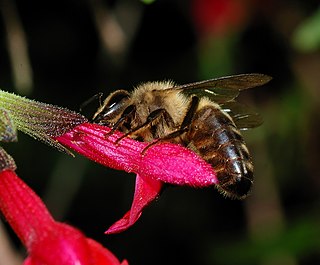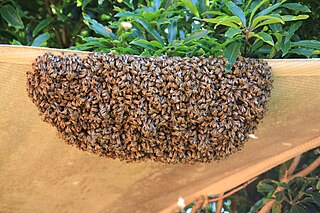Related Research Articles

A honey bee is a eusocial flying insect within the genus Apis of the bee clade, all native to mainland Afro-Eurasia. After bees spread naturally throughout Africa and Eurasia, humans became responsible for the current cosmopolitan distribution of honey bees, introducing multiple subspecies into South America, North America, and Australia.

The Africanized bee, also known as the Africanized honey bee (AHB) and colloquially as the "killer bee", is a hybrid of the western honey bee, produced originally by crossbreeding of the East African lowland honey bee (A. m. scutellata) with various European honey bee subspecies such as the Italian honey bee (A. m. ligustica) and the Iberian honey bee (A. m. iberiensis).

A beehive is an enclosed structure in which some honey bee species of the subgenus Apis live and raise their young. Though the word beehive is used to describe the nest of any bee colony, scientific and professional literature distinguishes nest from hive. Nest is used to discuss colonies that house themselves in natural or artificial cavities or are hanging and exposed. The term hive is used to describe an artificial/man-made structure to house a honey bee nest. Several species of Apis live in colonies. But for honey production, the western honey bee and the eastern honey bee are the main species kept in hives.

A beekeeper is a person who keeps honey bees, a profession known as beekeeping.
Beekeeping is the maintenance of bee colonies, commonly in man-made beehives. Honey bees in the genus Apis are the most commonly kept species but other honey producing bees such as Melipona stingless bees are also kept. Beekeepers keep bees to collect honey and other products of the hive: beeswax, propolis, bee pollen, and royal jelly. Other sources of beekeeping income include pollination of crops, raising queens, and production of package bees for sale. Bee hives are kept in an apiary or "bee yard".

A queen bee is typically an adult, mated female (gyne) that lives in a colony or hive of honey bees. With fully developed reproductive organs, the queen is usually the mother of most, if not all, of the bees in the beehive. Queens are developed from larvae selected by worker bees and specially fed in order to become sexually mature. There is normally only one adult, mated queen in a hive, in which case the bees will usually follow and fiercely protect her.

The Apis mellifera mellifera is a subspecies of the western honey bee, evolving in central Asia, with a proposed origin of the Tien Shan Mountains and later migrating into eastern and then northern Europe after the last ice age from 9,000BC onwards. Its original range included the southern Urals in Russia and stretched through northern Europe and down to the Pyrenees. They are one of the two members of the 'M' lineage of Apis mellifera, the other being in western China. Traditionally they were called the Black German Bee, although they are now considered endangered in Germany. However today they are more likely to be called after the geographic / political region in which they live such as the British Black Bee, the Native Irish Honey Bee, the Cornish Black Bee and the Nordic Brown Bee, even though they are all the same subspecies, with the word "native" often inserted by local beekeepers, even in places where the bee is an introduced foreign species. It was domesticated in Europe and hives were brought to North America in the colonial era in 1622 where they were referred to as the English Fly by the Native Americans.

The Caucasian honey bee is a subspecies of the western honey bee.

Varroa destructor, the Varroa mite, is an external parasitic mite that attacks and feeds on honey bees and is one of the most damaging honey bee pests in the world. A significant mite infestation leads to the death of a honey bee colony, usually in the late autumn through early spring. Without management for Varroa mite, honey bee colonies typically collapse within 2 to 3 years in temperate climates. These mites can infest Apis mellifera, the western honey bee, and Apis cerana, the Asian honey bee. Due to very similar physical characteristics, this species was thought to be the closely related Varroa jacobsoni prior to 2000, but they were found to be two separate species after DNA analysis.

Swarming is a honey bee colony's natural means of reproduction. In the process of swarming, a single colony splits into two or more distinct colonies.

Aethina tumida,commonly known as small hive beetle (SHB), is a beekeeping pest. It is native to sub-Saharan Africa, but has spread to many other regions, including North America, Australia, and the Philippines.

The Cape honey bee or Cape bee is a southern South African subspecies of the western honey bee. They play a major role in South African agriculture and the economy of the Western Cape by pollinating crops and producing honey in the Western Cape region of South Africa. The species is endemic to the Western Cape region of South Africa on the coastal side of the Cape Fold mountain range.

The western honey bee or European honey bee is the most common of the 7–12 species of honey bees worldwide. The genus name Apis is Latin for "bee", and mellifera is the Latin for "honey-bearing" or "honey carrying", referring to the species' production of honey.

Commercial Beekeeping in the United States dates back to the 1860s.
Beekeeping is first recorded in Ireland in the seventh century. It has seen a surge in popularity in modern times, with the membership of beekeeping associations exceeding 4,500. The median average number of hives per beekeeper is three hives, while the average honey output per hive is 11.4 kg. The growth in the practice has occurred despite increased pressures on bees and beekeepers due to parasites, diseases and habitat loss.
Beekeeping in the United Kingdom is the maintenance of bee colonies by humans within the United Kingdom. It is a significant commercial activity that provides those involved with honey, beeswax, royal jelly, queen bees, propolis, flower pollen and bee pollen. Honeybees also provide pollination services to orchards and a variety of seed crops.

Urban beekeeping is the practice of keeping bee colonies (hives) in towns and cities. It is also referred to as hobby beekeeping or backyard beekeeping. Bees from city apiaries are said to be "healthier and more productive than their country cousins". As pollinators, bees also provide environmental and economic benefits to cities. They are essential in the growth of crops and flowers.

Beekeeping in India has been mentioned in ancient Vedas and Buddhist scriptures. Rock paintings of Mesolithic era found in Madhya Pradesh depict honey collection activities. Scientific methods of beekeeping, however, started only in the late 19th century, although records of taming honeybees and using in warfare are seen in the early 19th century. After Indian independence, beekeeping was promoted through various rural developmental programs. Five species of bees that are commercially important for natural honey and beeswax production are found in India.
The Foundation for the Conservation of the Maltese honey bee is a Maltese non-governmental organisation aimed at the protection and conservation of the Maltese honey bee, a subspecies of the western honey bee.
References
- ↑ Hood, William Michael (n.d.). "Honey bee colony removal from structures". Clemson Cooperative Extension. Clemson, South Carolina, USA: Clemson University. Archived from the original on 2017-08-04. Retrieved 2017-10-30.
- 1 2 Dullas, William (7 August 2008). "Chapter 5: Bee removal operations". ABC's of Beekeeping problems and problem beekeepers. Bloomington, Indiana, USA: iUniverse. pp. 29–32. ISBN 978-0-595-53382-4.
- ↑ Pest, Killem (1 February 2022). Bee Relocation. Singapore.
{{cite book}}: CS1 maint: location missing publisher (link) - ↑ "Bee Removal vs. Bee Extermination - Live Bee Removal". dteklivebeeremoval.com. Retrieved 2021-04-29.
- ↑ O'Malley, M.K.; Ellis, J.D. (June 2008) [revised April 2016]. "Choosing the right pest control operator for honey bee removal: a consumer guide". Institute of Food and Agricultural Sciences (IFAS). EDIS Report ENY-144. Gainesville, Florida, USA: University of Florida Department of Entomology and Nematology (EDIS), UF/IFAS Extension. Archived from the original on 2017-10-12. Retrieved 2017-10-20.